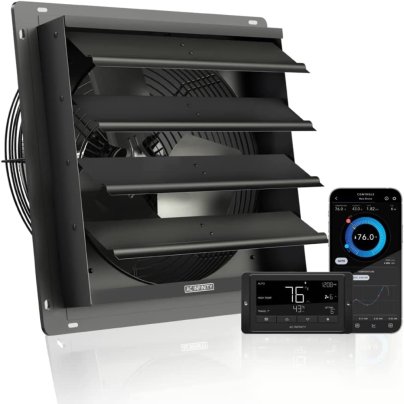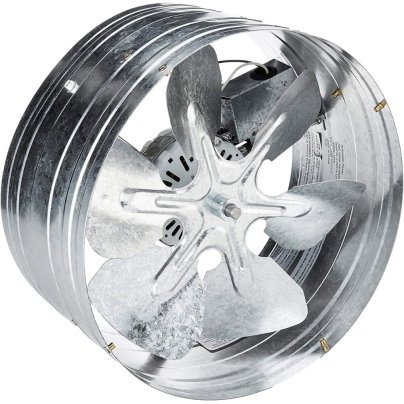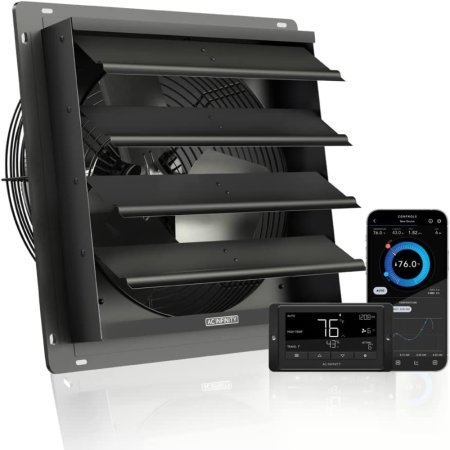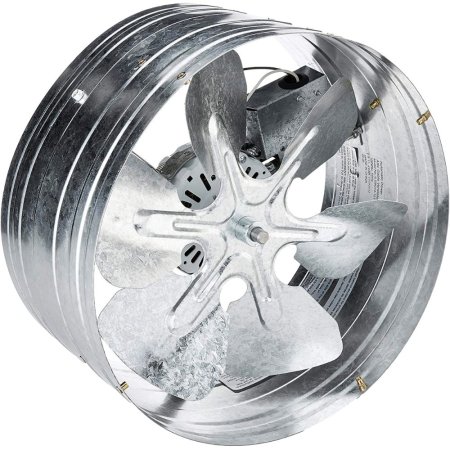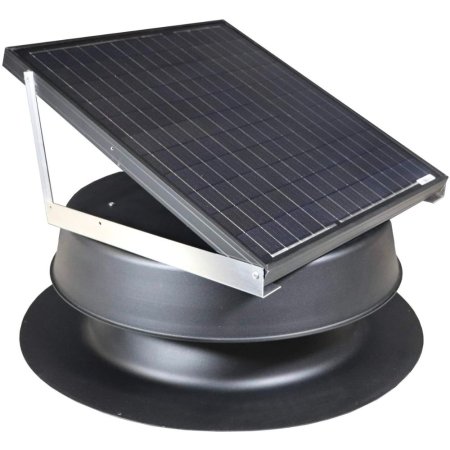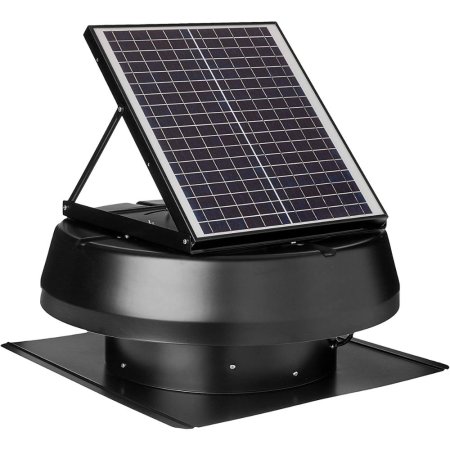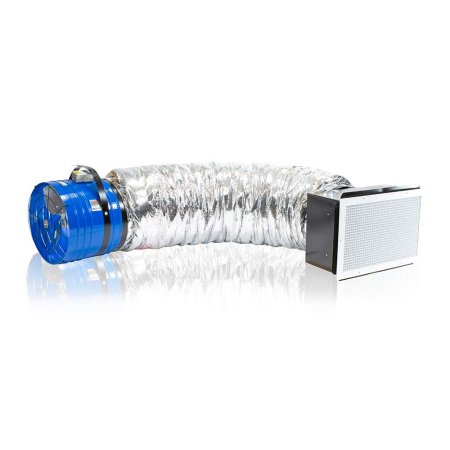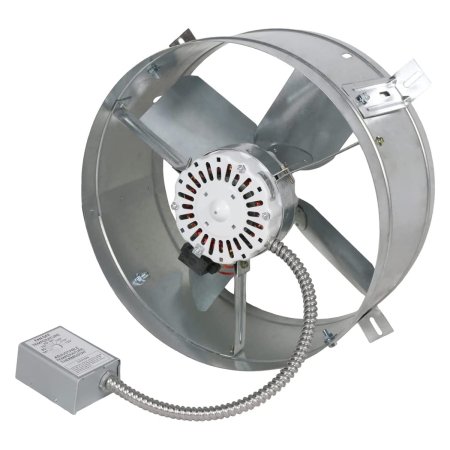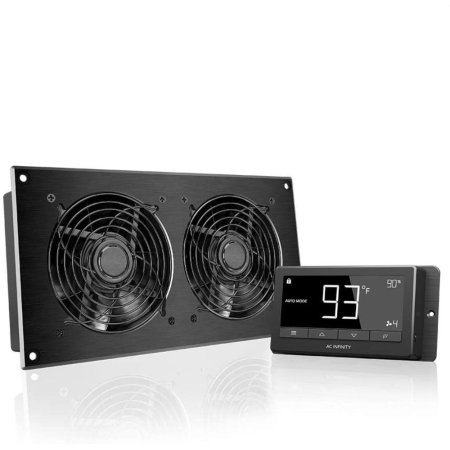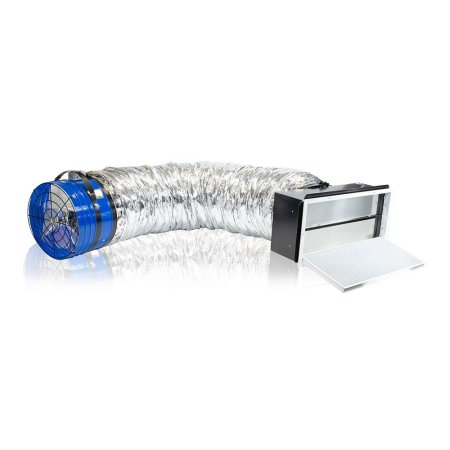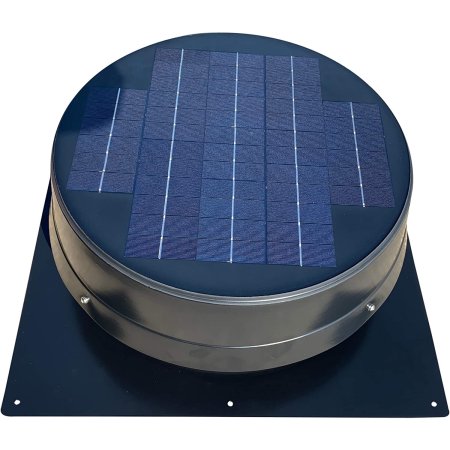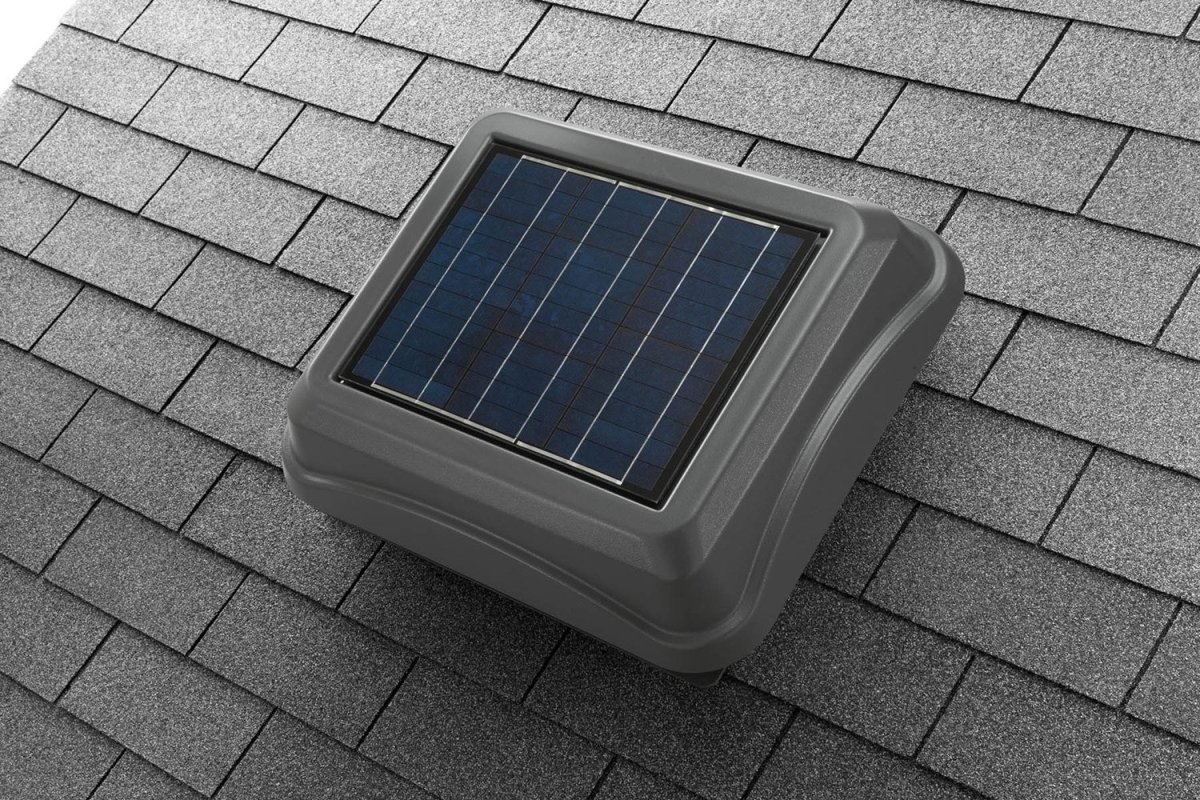
We may earn revenue from the products available on this page and participate in affiliate programs. Learn More ›
Many consider attic insulation safe and effective, but direct sun on a roof can radiate heat into the attic space, which promotes moisture and mold growth. Attic fans help push hot air out while also pulling fresh, cool air in through the vents in the soffit, gables, and ridge.
To find the best attic fan, make sure the fan is high quality and fits your home’s needs and your preferences. Some might prefer whole-house fans or solar attic fans, but if you don’t want a hole in your roof, there’s an answer for that as well.
- BEST OVERALL: AC Infinity Airlift T14 Shutter Exhaust Fan
- BEST BANG FOR THE BUCK: iLiving ILG8G14-12T Gable Mount Attic Ventilator Fan
- UPGRADE PICK: Natural Light 48-Watt Solar Attic Fan
- BEST SOLAR OPTION: iLiving ILG8SF301A Hybrid Smart Solar Roof Attic Fan
- BEST WHOLE-HOUSE FAN: QuietCool QC CL-3100 Whole-House Fan
- BEST FOR GABLE VENTS: Cool Attic CX1500 Gable Mount Attic Ventilator
- BEST WALL-MOUNTED: AC Infinity Airtitan T7 Wall-Mounted Ventilation Fan
- BEST QUIET: QuietCool QC CL-4700 Whole-House Fan
- BEST ROOF-MOUNT: Remington Solar 20-Watt Roof Mount Solar Attic Fan
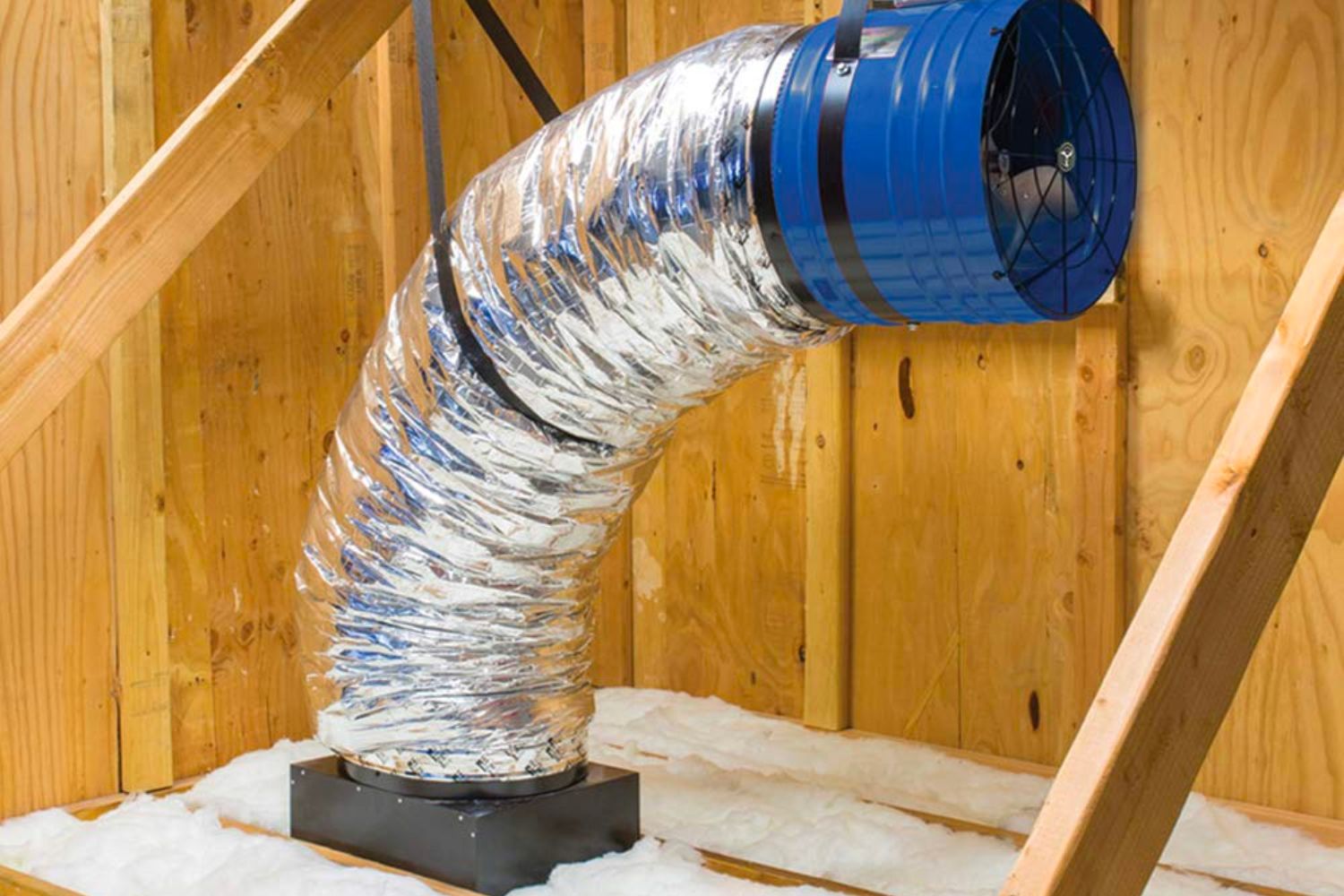
How We Chose the Best Attic Fans
Choosing the right attic fan can be difficult with so many sizes, power source options, constructions, and special features included. Many of today’s attic fans come with solar-powered or electrical designs, most of which are made with galvanized steel, aluminum, or plastic constructions. Since many are roof-mounted attic fans, some come with built-in flanges to prevent moisture and leaks.
Size is also something to consider, as most roof-mounted attic fans can fit into a precut hole in the roof, while others may require a new or larger hole to be cut. Many of the above solar-powered roof-mounted attic fans also automatically turn on when the sun is out, while other electrical options run at programmed times. Though both come with programmable thermostats, some of the solar-powered picks listed above may require another thermostat for cooler temperatures.
Cubic feet per minute (CFM) and square footage covered are also important when choosing an attic fan. As such, the options above are made for small or large spaces with 537 to 3,126 CFM ratings. Finally, most of these picks run at silent or very quiet noise levels, so the residents hardly even know they are there.
Our Top Picks
The following products are a collection of top attic fans for home ventilation. Each model excels in its category and will do an excellent job of reducing the issues excessive heat can cause in an attic. Whether you prefer solar attic fans, gable vent fans, or a whole-house model, there’s a product here to suit most needs.
Best Overall
AC Infinity Airlift T14 Shutter Exhaust Fan
Pros
- Features durable steel and aluminum construction to allow it to withstand attic conditions
- Includes a digital controller with a built-in thermostat and humidity control
- Bluetooth-enabled app allows users to make adjustments from their phones instead of trekking to the attic
- It does require an outlet, but there is a total of 28 feet of wire from the plug to the controller to the fan
Cons
- It might be just slightly loud for a finished attic space
Homeowners looking for a through-the-wall gable-style attic fan with all the bells and whistles should check out the AC Infinity Airlift T14. This high-tech attic fan features steel and aluminum construction, ensuring it can hold up to the rigors of attic ventilation. It produces up to 1,513 CFM, making it suitable for medium-size attics and even slightly larger spaces.
The Airlift T14 has some high-tech features as well. It has a fully programmable thermostat and humidity control, timers, alarms, speed adjustments, and more. All of these features are programmable from an LCD digital control panel. The entire system is also controllable from a Bluetooth-enabled app, and you can even link another attic fan to the control panel if you want more ventilation. It’s not solar, so it does require a power outlet, but the included cords total 28 feet from the outlet to the controller to the fan. It does produce 68 decibels, which might be slightly loud for a finished attic space.
Product Specs
- Material: Steel and aluminum
- Air volume (CFM): 1,513
- Noise level: Moderate
Get the AC Infinity Airlift T14 attic fan at Amazon or The Home Depot.
Best Value
iLiving ILG8G14-12T Gable Mount Attic Ventilator Fan
Pros
- Sturdy construction means that it will last years in a tough attic environment
- 3.1-amp motor covers 1,600 square feet, which is plenty for most attic spaces
- Built-in programmable thermostat means the fan doesn’t have to run at all times
Cons
- This unit does need to be hardwired into an electrical circuit
- Does not come with an outside vent cover or louvers, so those will need to be an extra purchase
For folks with access to their attic’s gables, iLiving’s gable-mount attic fan is a great option for moving air without cutting a hole in the roof. This model can be installed through the wall and capped outside with a vent cover to keep out pests and the weather.
This gable-mount attic fan features sturdy galvanized housing and a 3.1-amp motor that provides ventilation for up to 1,600 square feet of attic space. It also comes with a built-in thermostat that you can set to automatically activate and shut off the fan when the air gets to a certain temperature. For the value-minded shopper, this fan provides a lot of flow for the buck.
Two things to keep in mind about this gable-mount attic fan are that it does not come with an outside vent cover or louvers, and it requires hardwiring for power. It’s best installed near a gable vent.
Product Specs
- Material: Galvanized steel
- Air volume (CFM): 1,220
- Noise level: Low
Get the iLiving ILG8G14-12T attic fan at Amazon, Lowe’s, The Home Depot, or Wayfair.
Upgrade Pick
Natural Light 48-Watt Solar Attic Fan
Pros
- Built-in 48-watt solar panel allows it to operate without being wired or plugged into an outlet
- Covers over 2,825 square feet, making it more than sufficient for any large garage
- Adjustable angle from 0 to 45 degrees; 3/12 to 12/12 pitch roofs, allowing it to make the best use of sunlight regardless of the home’s positioning
Cons
- Cold-climate thermostat and fire-safety switch are sold separately
Natural Light’s solar attic fan may cost more than the other fans on this list, but it comes with some serious chops. This attic fan installs on a shingle roof and uses a 48-watt solar panel to draw energy from the sun. This model from Natural Light can move over 1,881 cubic feet of air—an impressive feat for a solar-panel-powered fan.
While the amount of air this solar attic fan model moves is astounding, it’s another unit that goes full speed anytime the sun is out. Some folks may want to purchase a separate thermostat to shut the fan off when it’s not needed, preventing it from burning out prematurely.
Product Specs
- Material: Aluminum
- Air volume (CFM): 1,881
- Noise level: Not listed
Get the Natural Light attic fan at Amazon.
Best Solar Option
iLiving ILG8SF301A Hybrid Smart Solar Roof Attic Fan
Pros
- Built-in 20-watt solar panel allows it to run during the day without house power
- IP68 waterproof brushless motor requires less solar power to run efficiently and should last for years
- Adjustable angles; 0, 15, 30, and 45 degrees, ensuring that it faces the sun regardless of the home’s positioning
- Smart thermostat control included to keep it from running unnecessarily; 65 to 130 degrees Fahrenheit
Cons
- Doesn’t come with a 120-volt adapter or screen guard, so those will have to be separate purchases
iLiving has a penchant for developing quality ventilation products, and this solar model is about as good as it gets. This attic fan uses a positionable solar panel that produces enough wattage to produce a massive 1,750 cubic feet per minute of air movement—more than enough for the average attic space and four times the power of a typical air conditioner.
Besides airflow, some additional features make this solar-powered model stand out from the crowd. Unlike other solar models, this one has a controllable thermostat, so it doesn’t automatically run just because the sun is out. This will drastically increase the life of the fan. Users can also upgrade it by purchasing a separate 120-volt adapter, allowing the solar attic fan to run at night—helpful in scorching climates.
Product Specs
- Material: Aluminum
- Air volume (CFM): 1,750
- Noise level: Moderate
Get the iLiving ILG8SF301A attic fan at Amazon, Lowe’s, The Home Depot, or Overstock.
Best Whole-House Fan
QuietCool QC CL-3100 Whole-House Fan
Pros
- Acoustically insulated duct and duct box included to keep noise to a minimum
- Built-in damper system blocks the fan and ductwork off from outside conditions when the fan’s not in use
- Easy to install since it’s designed to fit between ceiling joists
Cons
- Insulated doors not included; may require additional custom vent cover
The QuietCool CL-3100 is a model that does away with the well-known inconveniences of older whole-house fans. This model uses an acoustically insulated duct to keep noise to a minimum while still moving a lot of air—3,009 CFM to be exact, which is enough to pull fresh air through an average-size home.
The QuietCool installs easily through the ceiling with a duct box that fastens to the ceiling joists. The fan itself is on the far end of the duct, minimizing noise in the living space. Vented into a large attic space, you probably won’t even notice that this fan is running.
The fan doesn’t have any insulated doors that shut when not in use, so warm air may make its way into the attic when you don’t want it to. A custom vent cover may help with this.
Product Specs
- Material: Aluminum
- Air volume (CFM): 3,009
- Noise level: Low
Get the QuietCool CL-3100 attic fan at Amazon, Lowe’s, or The Home Depot.
Best for Gable Vents
Cool Attic CX1500 Gable Mount Attic Ventilator
Pros
- Built-in adjustable thermostat, so the fan doesn’t have to run at all times
- Covers over 1,850 square feet, which is plenty for most homes’ attics
- Affordable price point won’t require a huge investment to get some attic ventilation
Cons
- Requires a hardwire electrical connection as it doesn’t come with a plug
- Doesn’t come with louvers or doors to block it off from outside
When mounting a fan in the corner of a gable, the fan needs to be powerful enough to pull air from across the attic to work properly. This CX1500 model from Cool Attic does just that. It has a built-in adjustable thermostat that, when activated, starts its 1,300 CFM fan, cooling attics of up to 1,850 square feet in a hurry.
Buyers will appreciate that this gable vent fan can be installed through an exterior wall instead of a hole in the roof. It’s also constructed of sturdy galvanized steel, so it should be durable against moisture for a long time.
This is another model that requires an electrician to run power to its location, which you may want to consider when factoring in cost. It also doesn’t come with louvers or doors to separate it from the outside.
Product Specs
- Material: Galvanized steel
- Air volume (CFM): 1,300
- Noise level: Not listed
Get the Cool Attic attic fan at Amazon.
Best Wall-Mounted
AC Infinity Airtitan T7 Wall-Mounted Ventilation Fan
Pros
- Programmable temperature range and airflow to prevent it from running unnecessarily
- Versatile construction; fits over air conditioning vent or simply vents outside
- Affordable price point allows users to vent their attics without a huge investment
Cons
- Suitable for small crawl spaces or basements thanks to its compact size (but relatively low airflow)
For homeowners with partially finished attics who want help controlling excessive heat, this AC Infinity Airtitan T7 fan might fit the bill. This model is small enough to fit over an air conditioning and heating vent but can also be vented outside, running at a programmed temperature range. It only moves 240 cubic feet of air per minute, which is suitable for smaller spaces in a home.
The AC Infinity Airtitan T7 offers a lot in the way of programming. Not only are temperature controls available, but you can also program alarms, timers, and even an economy mode. The dual fans are also quiet (32 decibels), making them hardly noticeable as the fan battles an attic’s temperature.
This unit has to be vented through the wall and won’t fit most gables, but its compact size means that it should fit between wall studs without an issue.
Product Specs
- Material: Anodized aluminum
- Air volume (CFM): 240
- Noise level: Low
Get the AC Infinity Airtitan T7 attic fan at Amazon or The Home Depot.
Best Quiet
QuietCool QC CL-4700 Whole-House Fan
Pros
- The fan is installed at the end of the insulated ductwork to keep noise to a minimum
- Produces over 4,000 CFM, which makes it suitable for homes up to 2,207 square feet
- Insulated doors prevent heated or cooled air from escaping into the garage
Cons
- Vents warm air from the house into the attic, so it will require ventilation in the attic as well
When it comes to quiet whole-house fan ventilation, the QuietCool QC CL-4700 whole-house fan has plenty to offer. This model features a fan installed at the end of a self-contained insulated piece of ductwork to reduce sound and noise vibration inside the home. This allows users to quietly remove warm air from the entire home and replace it with cool air—it registers at just 50 decibels.
The CL-4700 fan creates 4,415 CFM. That allows this powerful fan to ventilate a home up to 2,207 square feet. It also features a split-capacitor motor that improves energy efficiency and a damper system that QuietCool claims prevents heating and cooling loss. Just keep in mind that it will require ventilation in the attic, so it’s not suitable for airtight attics.
Product Specs
- Material: Insulated ductwork, steel housing
- Air volume (CFM): 4,415
- Noise level: Low
Get the QuiteCool CL-4700 attic fan at Amazon or The Home Depot.
Best Roof-Mount
Remington Solar 20-Watt Roof Mount Solar Attic Fan
Pros
- Seamless shroud and flashing to prevent any potential leaks
- Made from powder-coated steel and stainless steel parts for durability and longevity
- Features built-in thermostat and humidity control that automatically activate
Cons
- Users cannot adjust the thermostat’s preset range
Folks aiming to vent their attics through the roof should consider the Remington Solar 20-watt roof mount solar attic fan. This model installs atop a shingled roof, and the flashing and shroud are seamless, ensuring there won’t be any leaks. It features durable powder-coated steel construction and stainless steel parts to ensure it will last for years.
This solar attic fan features built-in photovoltaic solar cells that power it during the day. It also has a built-in thermostat and humidity control that activates it at 80 degrees Fahrenheit and 75 percent humidity and shuts off below 65 degrees or 55 percent humidity. Unfortunately, you can’t adjust the solar attic fan’s thermostat, but you don’t have to activate it manually.
Product Specs
- Material: Powder-coated steel, stainless steel
- Air volume (CFM): 1,280
- Noise level: Not listed
Get the Remington Solar attic fan at Amazon or Remington Solar.
Jump to Our Top Picks
What to Consider When Choosing an Attic Fan
Here are some helpful tips to keep in mind when choosing an attic fan. You’ll want to understand the different capabilities and functions of models as well as the material they are constructed from. And, most importantly, there are some safety considerations to remember before setting out to install a new attic fan.
Types of Attic Fans
Homeowners can use a couple of different attic venting fan styles to help control the temperature of their attic space. However, their functions differ somewhat. Depending on the layout, a home may be better suited for one of the following types of fans.
Whole-House Fans
Whole-house fans are installed into the ceiling of the highest point in the finished space—typically an upstairs hallway. When running, they pull heat and moisture from inside the house and force it into the attic space. They’re ideal for homeowners who like to open their windows at night, as the cool nighttime air replaces the hot air built up during the day.
The issue with a whole-house fan is that the hot air needs somewhere to go. If the attic isn’t ventilated well, that humid, moist air will build up in the attic space and can cause mold to grow. Therefore, whole-house fans are best suited for homeowners with spacious, open, well-vented attics.
Attic Venting Fans
Attic venting fans serve a different function: They remove the hot and moist air from the attic and leave the space below the attic floor alone. These fans circulate the air within the attic, pulling fresh, cool air from the vents (like the ones in a soffit) and pushing hot air outside.
Attic fans can serve a year-round function. In the summer, you can drastically reduce the temperature in the attic, helping to lengthen the life of the roofing shingles and sheathing.
In colder months, attic fans can help avoid damage caused by ice dams as well. The fans cool the attic, equalizing the temperature between the attic and the outside. This prevents snow from melting on a roof and freezing when it hits the cold gutter.
When installing an attic fan, it’s important to consider how well the attic is sealed off from the rest of the home. If an attic door or hatch is particularly drafty, turning the fan on will pull air-conditioned or heated air through the gaps, heating or cooling the neighborhood.
Material
An attic fan must be built from material sturdy enough to survive the excessive heat that can build up in an attic. Cheaper fans with plastic components may begin to fail over time under these conditions. In the winter, plastic often becomes very brittle, making it easy to snap the fan blades under normal use.
Instead, choose a fan with metal construction. The body and the fan should both be constructed of sheet metal and steel, galvanized or painted if possible. These materials are far more stable than plastic in fluctuating temperatures and hold up well against moisture.
Ease of Use
Attic ventilation does no good if it’s too much of a hassle to turn on or off. Many whole-house models now come with remote controls, which allow users to turn the fan on from the floor below and customize its settings with the touch of a button.
Attic fans are great for those who want to forget that their fan is there. Most fans either come with a programmable thermostat or can be wired to one, which will turn it on when the attic reaches a set temperature—no need for flipping a switch or monitoring the attic’s temperature.
Safety
One very important aspect to consider when deciding if an attic fan is the right choice is safety—particularly around furnaces installed in an attic. An attic fan can create enough draft to blow out a pilot light on a furnace.
If this happens, the furnace will empty gas into the attic. At first, the fan will alleviate most of the danger by forcing the gas outside, but it’s a different story once it shuts off. An attic can fill with gas and then seep into the rest of the home, posing a danger to the residents.
Whole-house and attic fans can also pull carbon monoxide back into the home through a damaged flue. Be sure that the flues are in good operating condition and that the furnace, oven, fireplace, and other appliances that use fuel are ventilating properly.
Venting Requirements
Understanding the venting requirements for the attic fan chosen is important for a few reasons. An attic fan requiring more ventilation than an attic can offer will begin to pull air from inside the conditioned space. This negates whatever energy efficiency the homeowner was hoping for. Too much ventilation, and you may find the fan doesn’t work efficiently at removing the hot air from the entire attic.
If a whole-house fan doesn’t have the proper ventilation, it won’t work very well either. It’ll fill the attic with hot air, stopping it from pulling more air into the space through open windows.
Adjustable Thermostat
Attic fans are similar to air conditioners in that they have adjustable thermostats whereby users can set a dial and forget about the fan. When the temperature within the attic reaches a set point, the fan will turn on and start venting the heated air, cooling the attic space.
Likewise, adjustable thermostats will shut the fan off when the temperature drops back below the set temp. They’re easy to use and help save money by not running the fan when it doesn’t need to be on.
Air Volume (CFM) and Square Footage
The higher the CFM, the more airflow a fan can produce. Choose a fan that matches a home or attic’s size for optimal performance. Too high of a CFM, and you’ll be spending more money running the fan than you should be. Too low of a CFM, and you’ll just be spinning your wheels, with little positive impact on the home.
Not all fans will come with CFM ratings emblazoned on the packaging. Instead, look for the amount of square footage the fan was intended for. This detail is especially important in choosing a whole-house fan.
Noise Level
Ah, noise—the bane of all whole-house fan owners since the dawn of whole-house or quiet plug-in fans. But no longer. Newer, smaller, and more efficient models can run at much quieter levels, keeping the house cool in relative silence.
If an older fan is installed in the home, switching to a newer whole-house fan will provide a noticeable change in noise. The newer models have smaller fans, create less turbulence, and their motors are better tuned than the massive house fans of old.
FAQs
Most attic fan manufacturers have excellent customer support teams, so if there are any questions about the specific models on this list, you might want to give the company a call. If you’re still not entirely sure how an attic fan or whole-house fan works, or if you have other general questions about attic fans, here are some answers that might help.
Q. How does an attic fan work?
An attic fan works by exchanging the hot air in your attic space for fresh air pulled through the vents. This will help avoid premature damage to the shingles or mold in moist, hot attics.
Q. How do you install an attic fan?
You install an attic fan through the roof and flashing under the shingles. Gable fans are installed at the very top of your gable-end walls and vented through the walls outside. Whole-house fans require cutting through the finished ceiling on the highest floor of your home and ventilating outside.
While a DIYer can wire these fans, it’s best to call an electrician for the job.
Q. Can you replace the attic fan motor?
You can, but models with accessible fans are usually pretty affordable to replace entirely. If you do want to replace the motor, bring it to an electrical shop, and they should be able to match you up with a new one. If not, they may be able to rebuild the one you have.
